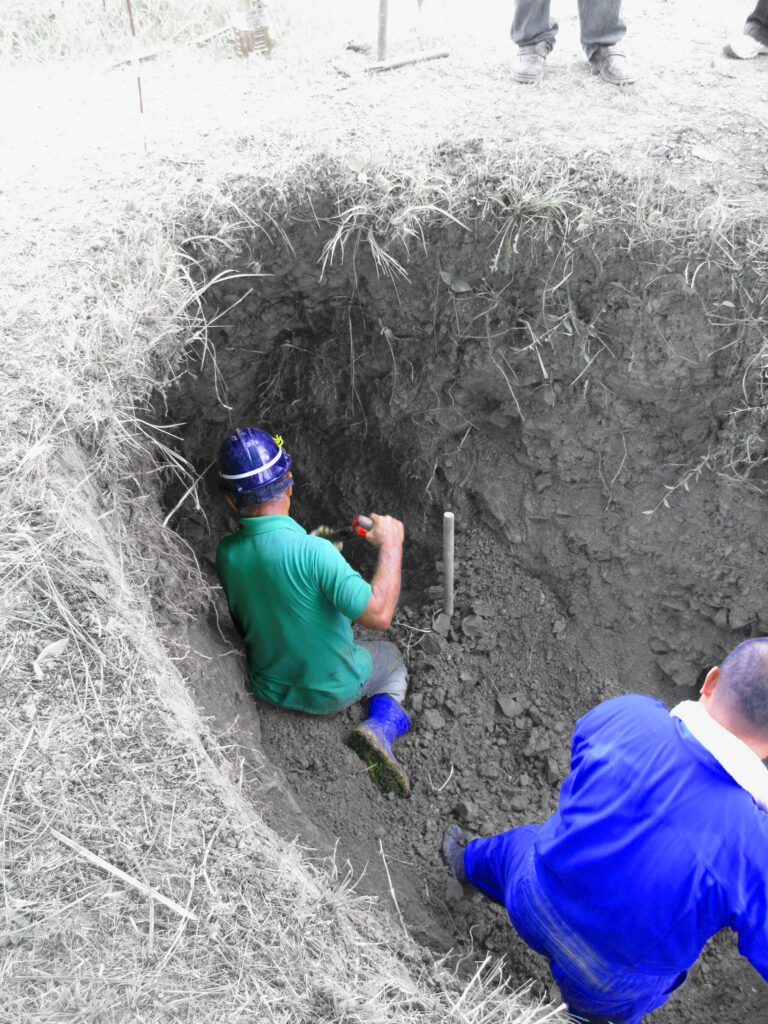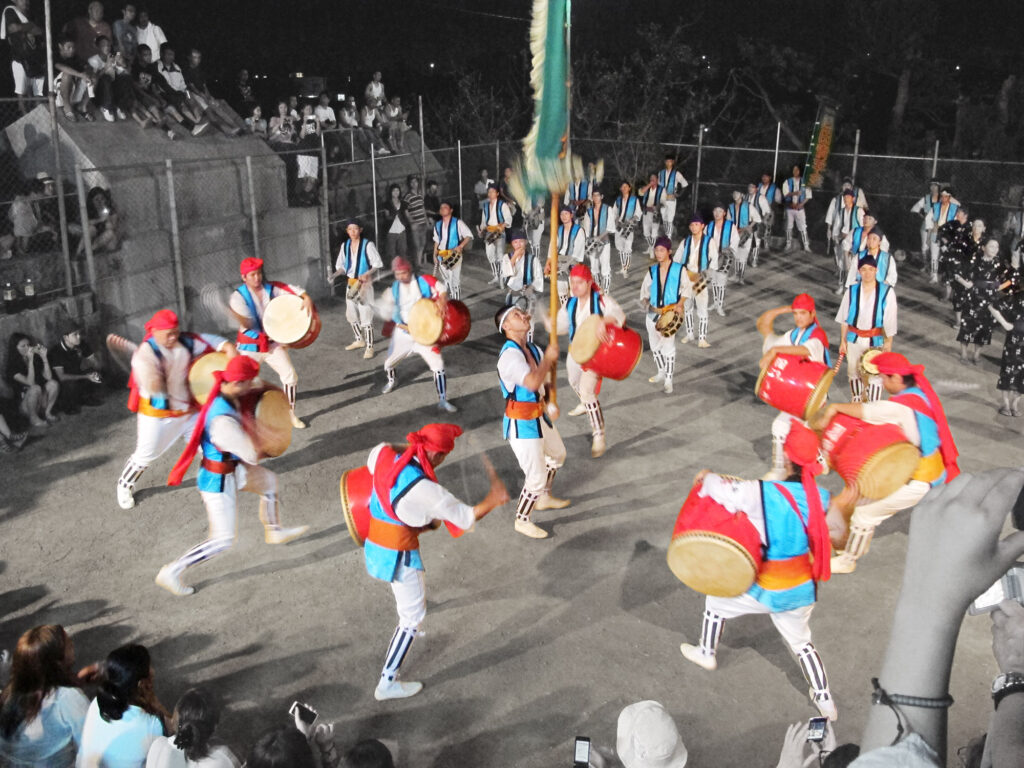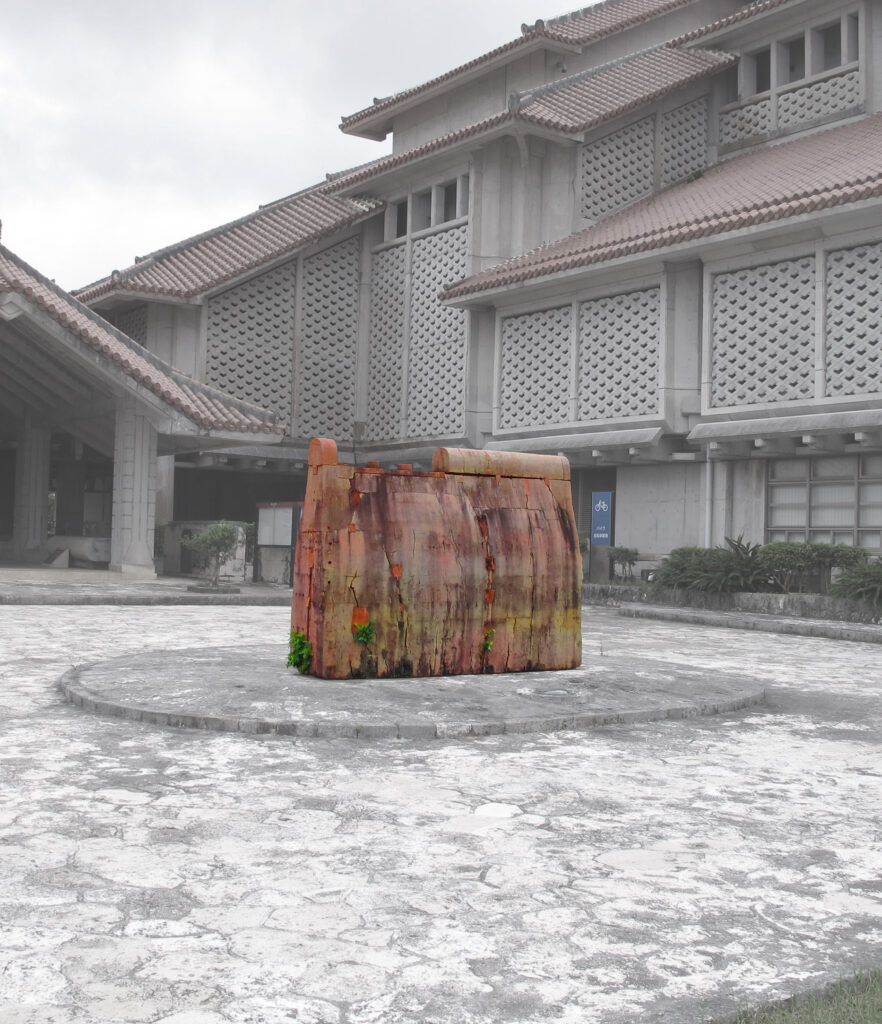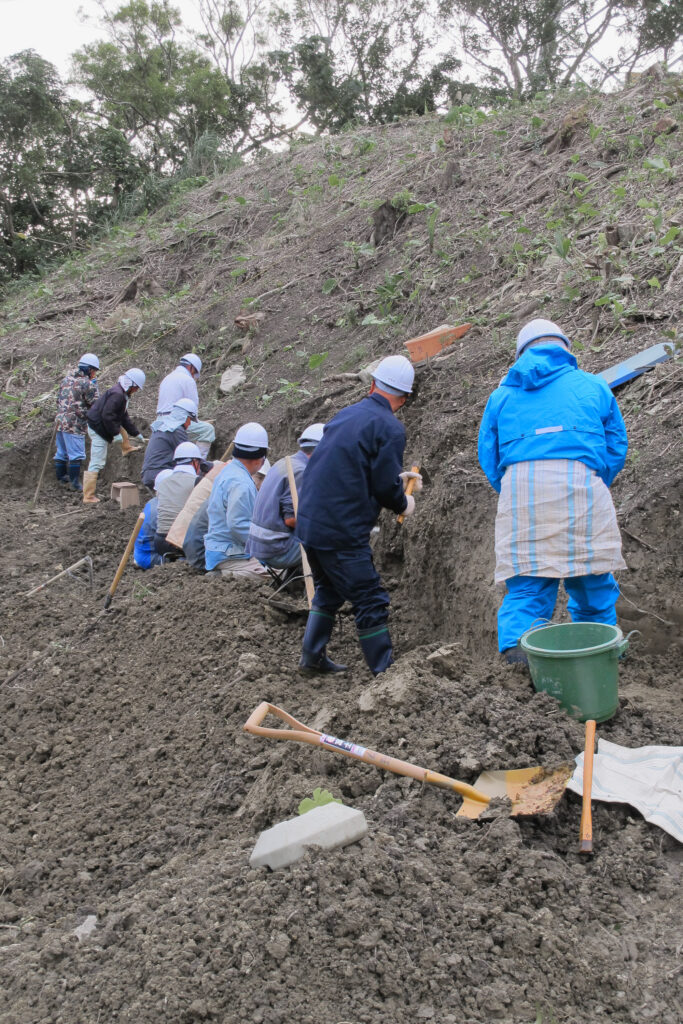
Dangerous Voices, Ghostly Alliances
The dead in Okinawa help us imagine a politics of the weird.
My Okinawan friends have told me that a call may come from the world of the dead at any time. Disturbing and even potentially frightening, the spirits of ancestors may reach out in dreams, appear in visions, or make their presence known through the bodies of the living. Perhaps they need to be fed, to be offered tokens of respect, or simply to be remembered. The dead may emerge to conjure and reconfigure mutual care between ancestors and descendants. Or, they may mobilize these capacities in creative ways, adapting to a world shaped by forces of change.

Digging for remains at Nakagusuku Castle
In 2009, an Okinawan laborer working to recover the remains of imperial Japanese soldiers (at a construction site in what had been a World War II battlefield) told me that he had received just that kind of call. A boy in the uniform of a neighborhood elementary school told him that he had seen a pair of men in worn military uniforms beckoning to him beyond the excavations. When he and his friends went there and began to dig, they uncovered the remains of two soldiers, huddled together in the abandoned foxhole where they had been killed. The soldiers’ remains were recovered, cleaned, and interred in a national tomb alongside those of their wartime comrades. Their uneasy rest was reshaped; their final burial transformed them from lost casualties into honored national heroes.
The living were also transformed. At that time, the laborers working on this project had no other options besides living rough in Okinawan parks. Having attended to this ghostly summons, they became recognized as skillful, patriotic specialists who could recover the hidden remains of those who had sacrificed themselves for the state. The recognition they received for their work, conferred by the dead, helped to found a residential center that provided new opportunities for them.1

Sonda Seinenkai (youth group) entertaining the living and the dead
Though notably transformational, this encounter was not necessarily exceptional. Contemporary Okinawa contains and shapes its own particular milieus of the living and the dead. My friends who have experienced encounters like this with the dead tell me that they are already aware of belonging to a world that includes the presence of spirits, and that this belonging comes with expectations and responsibilities. Though these spirits, deities, and other nonhuman entities are invisible, Okinawans know them, and they know the places in the landscape where they dwell. While they might extend themselves toward these entities, attending to them or seeking their help, they know that spirits are not passively waiting to be discovered. They may be reaching out to us.
There is a quotidian rhythm to these relationships in Okinawa. People make daily offerings at household altars and neighborhood shrines. Families clean tombs with care, and children leave gifts in the spaces where these beings are known to gather. People live with the punctuating rhythm of seasonal festivals. They welcome the spirits of the dead to visit, and encourage them to return to their own places when the holiday has ended. They picnic before the family tomb, sharing their meals with the dead, reporting on what’s happened over the past year, asking for help in the year to come. And there are other, less regular gatherings: to help a child find a path in life, to help a young person become an adult, to aid the once-living in their transition to the world of the dead. In each of these encounters comes a moment of mutual recognition between the living and the dead: as members of the same community, as ones who care about and remember one another, as ones who are powerful and productive.

Hinpun, a wall that blocks the movement of evil, at the Okinawa Prefecture Archives
These relationships take shape over turbulent terrains. Contemporary Okinawa is wracked by global and local economic crises. It is shaped by the traces of Japanese colonialism, by the presence of American military imperialism, and by the material and conceptual forces of the nation and the state. Okinawans live with the pressures of poverty and environmental degradation, and with the memory and apprehension of war. It is against these forces that the weird manifests itself as a token of things that do not change in a changing world— a sign that something half-remembered may be about to erupt into everyday life.
“While they might extend themselves toward these entities, attending to them or seeking their help, they know that spirits are not passively waiting to be discovered. They may be reaching out to us.”
In this context, the encounter, excavation, and interment of the soldiers in 2009 was, in a sense, radical. Since the late nineteenth century, imperial Japanese soldiers have shaped Okinawa through violent colonial transformation. During World War II, in the Battle of Okinawa, they turned Okinawan communities into battlefields, conscripted Okinawan civilians by force, left many to die of starvation or injuries, and executed others. Japanese soldiers demanded that Okinawans—forced to act as loyal Japanese subjects—murder their own families and kill themselves in defiance of the American invaders. Imagine the audacity and the desperation of the spirits of former colonizers, reaching out for help from the children of those they dominated and destroyed.

Residents of Sonda in Okinawa City making offerings at their old village shrine inside Kadena Air Base
At the same time, what the 2009 summons accomplished was rather conventional. The dead were rescued from abandonment, and they received the consideration due to them for sacrificing themselves for the nation. In turn, the workers who uncovered them were accorded the respect that they had earned through their appropriate care for the dead.
But the living and the dead, the seen and the unseen, can come together in even more creative and transformational ways. Consider the experience of the photographer and activist Higa Toyomitsu, one of the most famous artists in Okinawa. Higa’s work challenges the boundaries between the aesthetic, the documentary, and the political. He is a constant critic of Japanese exploitation and oppression, a relentless opponent of American military occupation, and a fierce advocate for a free Okinawa. Like the workers who recovered them, Higa was also summoned by these dead imperial Japanese soldiers. In his case, he called it sashindāri—he was called to photograph their remains.

Recovering human remains from the slopes below Untama Forest in Okinawa
After months of laboring alongside the workers in their battlefield excavations and taking thousands of digital and film photographs, Higa exhibited the images across Japan. Reproduced in magazines and displayed in galleries and museums, his images do many things. They remind those who may have forgotten—and they teach those who may never have known—that the traces of war still lie just beneath the surface of contemporary Okinawa, and of Japan more broadly. They capture the moment of wartime death in all its horror. Some soldiers remained huddled in the shelter of abandoned tombs, killed by American bombs and guns. Others were blown apart after detonating grenades in their own laps in acts of patriotic defiance. In Higa’s images, there are intimations of debts unpaid and obligations forgotten, of a state that left these soldiers behind and failed to honor their sacrifices. The photographs also register the transformation wrought over nearly seven decades in the ground. These remains have shed the trappings of war, their uniforms and weapons stripped away along with their flesh, their bones dyed a deep mahogany by the pigments in the Okinawan soil.
For the visitors who stood before these photographs in galleries and museums, for the readers who gazed at them, page after page, in magazines and journals, the experience was intense. However, Higa argued that the dead expected him to do more than just represent these transformations. They wanted him to record the moment of their re-emergence into the present—to capture their continuing power to shape the worlds of the living.2
Why did these dead soldiers want Higa to photograph them as they returned to the world? In their material presence, in their broken bones and shattered skulls, they instantiate the consequences of sacrifice to a social order, to an ideology that demanded everything of them. Still, any photographer could represent that. The soldiers’ appearance to him at that particular moment demonstrated that, in the years beyond death, they had changed. They had revalued themselves. Higa insists that they have returned to demonstrate their determination to act in this new moment. They have re-emerged as Japan and the United States are again expanding their military presence in Okinawa, building a massive and controversial new Marine Corps air base to the north in Henoko, and constructing new Jieitai (Japanese Self-Defense) installations across the islands. Their ghostly potency punctuates a moment when the games of war in the seas and skies surrounding Okinawa have become increasingly confrontational and dangerous.
The images that Higa created allow the soldiers to remain present in this moment of crisis, to resist banishment to some distant, patriotic burial. They are altogether too weird for any pat reinscription into a mythos of heroic, settled death; they will continue to address those who view them in galleries, in libraries, in classrooms, and in the home. There, these ghostly alliances will continue to conjure new horizons of possibility. It is through their radiant weirdness that Higa’s collaborations with the dead strive to disrupt narratives of violence and sacrifice, to demonstrate that change is possible, and to open the way to a new form of cooperation with the living.
In pondering these politics of the weird, it doesn’t seem to be enough to recognize that the pleasure and the pain of our daily lives is dependent on the actions of vast forces, unseen and unseeable. For generations, social scientists and critical theorists have laid bare these structures and processes. We have long recognized that these conditions are produced by our own actions and understandings, and that we ourselves could be the authors of a transformational politics that liberates us from them. And yet, this hasn’t diminished our sense of the monstrous alterity of those forces, of the burden of immense suffering and death, of the ever-present danger of violence and exploitation that can seize us at any time, or of the inadequacy of our categories of understanding.3 Perhaps we need to pair our critical politics with an attentiveness to other entities, other forces, and other possibilities that may already affect us. After decades of ethnographic work in Okinawa, I have some sense of the form that a politics like this might take.
Okinawa offers countless examples of conventional protest and opposition, of rigorous critique and informal resistance. And yet, in my years of studying these relationships between the living and the dead, I’ve also learned about vast, complex networks of entities that exceed the human, which have the capacity for creating new forms of kindness, cultivating new forms of community, moving across boundaries. These unseen relationships bind the individual and the collective, the modern and the traditional, the cultural and the natural in ways that challenge the very stability of such categories. And while they may seem weird or dangerous to the humans that mobilize and interact with them, they are still characterized by familiarity, knowledge, and affect that make them open to new possibilities.

Abandoned tombs being transformed in an urban reconstruction project in Central Okinawa
From the Okinawan battlefields to our own homes, the respective situations that we face are not the same. But perhaps there is something to be learned from these weird collaborations. The voices of our dead, the whispers of machines, the silences of the nonhuman world may be extending themselves toward us. As they reach out and into our lives, it’s worth asking: Haven’t they also been appropriated, distorted, and destroyed by the forces of capital and practices of domination? In the excess, violence, and death that surround us, is there some possibility of mutual recognition? Some faint trace of hope? Perhaps like the casualties of war in Okinawa, there are things that might refuse to remain what they once were. They might struggle to transform themselves, to create new alliances. How can we anticipate that weird moment? How might we listen for that call?